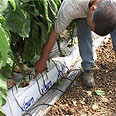
The ground beneath our feet
Tens of thousands of work places for Palestinians in Gaza is tantamount to the loss of livelihood for thousands of Israeli vegetable farmers
A tiny article about an agreement between strictly Orthodox representatives and vegetable growers in Gaza recently appeared in the newspaper. The latter undertook to provide the former thousands of tons of vegetables during 2008, which is set to be a fallow year (shnat shmita).
At the core of the mitzvah of the fallow year is the obligation to allow fields to fallow every seventh year after the first harvest. Namely, to refrain from cultivating fields or enjoying their yield for the duration of one year. Since the days of the first aliyah to date the mitzvah of shmita has been at the core of a fierce dispute between non-Zionist strictly Orthodox and religious Zionist societies.
It is the commitment to values according to which the agricultural enterprise led religious Zionism to support the halachic solution of the sale of land as a means of enabling the continuation of agricultural work.
During the last fallow year in 2001, a particularly fierce dispute broke out in which Chief Rabbi Bakshi Doron threatened to resign. The background to this decision was an attempt by the strictly Orthodox community to further expand their strict halachic approach by subjecting the issuance of a kosher certificate to sales of Arab agricultural produce only.
'We can't expect much from Orthodox community'
At first glance this looks promising. Hope isn't entirely lost. A group of Jews in Israel reached a commercial agreement with the farmers from the Gaza Strip despite the escalation in violence. The hope embodied in the agreement is apparently increasing in light of the assumption that the project is likely to provide Palestinians in Gaza more than 10,000 places of employment. For years now we have been told that their economic plight is what is pushing them into the arms of Hamas.
One of the focuses of the national struggle between Jews and Arabs, including within the Green Line, is on holding and controlling land. Frequent articles are publicized debating the loss of the State's control over its land. The trend to relinquish agriculture - which has led to the loss of land - has been added to the economic trend in recent years which is narrowly examining every area through the prism of cost-effectiveness and financial loss and profits.
However, the status of the land is not only determined by its official-legal status. Testimony of this is the hundreds of thousands of hectares registered as State land that can only be accessed by State representatives accompanied by Border Police. The real, stable and continued hold over the land can only be achieved by settlement, and more so by means of active agricultural enterprises.
Tens of thousands of work places for Palestinians in the Gaza Strip is tantamount to the loss of livelihood for thousands of Israeli vegetable farmers. The blooming fields surrounding Dir El Balah means an additional loss of land within the Green Line. There is a high probability that the funneling of substantial funds to farmers of the Strip will mean additional finances for purchasing arms.
We can't expect much from the strictly Orthodox community due to the halachic approach that precedes long-term national considerations, particularly when the considerations reek of Zionism. In the prior dispute, in 2001 religious Zionism was characterized by a thunderous silence, except for a few. Now they have the chance to rectify the distortion by taking a firm stance against the haredi sectarian stance, while demonstrating a stance that is committed to both religious tradition and Zionism.
Dr. Asher Cohen is a lecturer of political science at Bar Ilan University.










